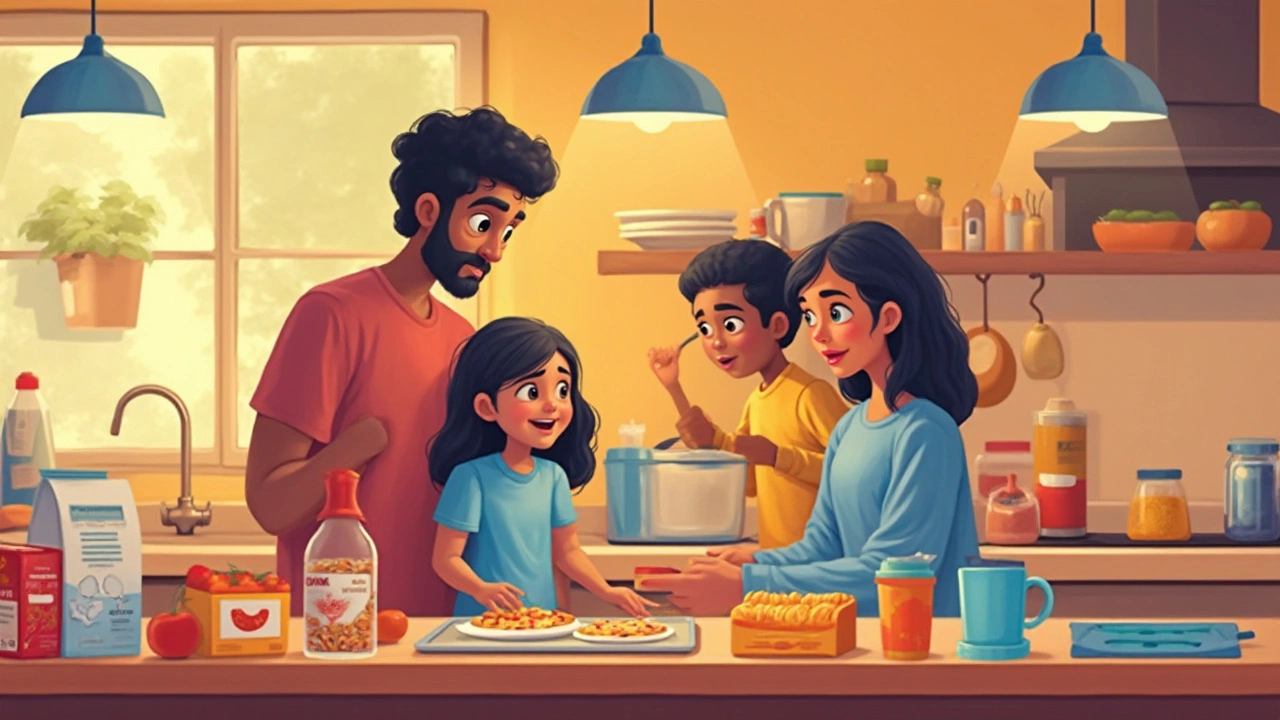Picture this: You roll out of bed, grab a seemingly harmless bowl of cereal, maybe add a splash of juice, and you’re off. By lunchtime, you might snatch a meal deal—sandwich, crisps, fizzy drink—easy, cheap, satisfying. Dinner could be a ready meal or pizza because who has time after a long day? Now, think about how many times sugar or processed ingredients sneak their way into each meal. Between the marketing spin and the endless supermarket options, it’s no wonder the scales keep creeping up for so many people.
Why Sugar and Processed Foods Are Everywhere
Wander into any large UK supermarket, and you’re hit with aisles upon aisles of brightly packaged, long-shelf-life food—biscuits, ready meals, fizzy drinks, cereals, even sauces. This isn’t by accident. Food manufacturers have engineered these products to be cheap, convenient, and yes, addictive. Hyper-palatable foods make you want just one more bite, then another, and then suddenly the whole bag is gone. The trouble is, these foods are everywhere. A 2023 Food Standards Agency review found Brits now get over half of their calories from ultra-processed foods (UPFs). That’s not just cakes and cookies; it’s breakfast bars, flavoured yoghurts, store-bought bread. Even my favourite lunchtime hummus often comes loaded with processed vegetable oils and stabilisers.
Sugar is often hiding in plain sight. Did you know that things labelled as “low-fat” often have extra sugar to make up for lost flavour? The list of sneaky names for sugar keeps growing—glucose, fructose, dextrose, high-fructose corn syrup—you get the idea. Ingredient lists can read like a chemistry set, masking just how much of the sweet stuff is in your trolley. The British Nutrition Foundation explained in 2024 that, on average, adults here eat twice the recommended daily free sugar intake (which is just 30g, or about seven teaspoons). Kids? It’s worse. The average British child gets almost three times that amount.
What’s frightening is the power of clever marketing. Yo-yo diets and low-calorie promises keep us buying new products, each loaded with different processed ingredients. Healthy-looking snacks—think granola bars or fruit-flavoured yoghurts—are made to feel wholesome but often pack as much sugar as a chocolate bar. And that’s before you get to the drinks: a single bottle of cola can have as much as 13 teaspoons of sugar. Coffee shop frappés are no better.
The Science – How Sugar and Processed Foods Mess With Your Body
When you eat sugar, especially in the massive doses typical today, your body goes into overdrive. Sugar causes your blood glucose to spike, which feels good for a little bit but drops you fast. Insulin, the hormone that controls glucose, starts working hard, pushing that sugar out of your blood and into your cells. Over time, constant high sugar intake makes your body less sensitive to insulin. That’s how you get insulin resistance, and eventually type 2 diabetes. And guess what? You only need to look at NHS data: about 90% of type 2 diabetes in England is linked to excess weight, and excess weight is being fuelled, largely, by high-sugar, highly-processed food.
Processed foods come packed with simple carbs. They’re digested quickly, leaving you hungry again soon after eating. That’s why munching through a pack of crisps or biscuits feels bottomless. Additives like emulsifiers and flavour enhancers might keep your senses happy, but they mess with your gut’s natural bacteria. A 2023 University of Bristol study showed that people who eat more processed foods have less gut diversity, which in turn can make it harder for your body to regulate weight.
The calories in these foods hit quickly, and for most people, they don’t trigger the fullness signals that real, whole foods do. Your brain’s reward system lights up with every gulp or bite, making it easy to lose control and overeat. It’s not all your fault—flavour chemists literally design these foods for maximum craving. The end result? You store more fat, especially around your organs. This kind of weight gain is the most dangerous. Visceral fat is linked to heart disease, stroke, and certain cancers. NHS numbers show that more than 60% of UK adults were overweight or obese in 2024, with hospital admissions related to obesity tripling in the last ten years.

Spotting Hidden Sugars and Processed Ingredients
You probably know to check obvious suspects like sweets and fizzy drinks. But what about savoury items? Tomato soup, salad dressings, baked beans—even those can be sugar traps if you’re not careful. Then there are seemingly innocent choices like oat milks or protein bars. Walk through any high street shop, and it’s surprising how often "healthy options" are packed with sugar, salt, or fatty fillers. Foods with labels like 'lite', 'low-fat', or 'diet' can be particularly sneaky.
Here’s a quick hack: check the ingredient list. If sugar (or its many cousins like maltose or syrup) is in the first three ingredients, it’s probably not a healthy staple. Processed foods often have ingredient lists a mile long. Compare that to a whole apple, which really needs no label at all.
Take a look at this useful table of common household foods and their not-so-obvious sugar content, based on data from Public Health England (2024):
| Food Item | Typical Portion | Grams of Sugar | Grams of Fat | Note |
|---|---|---|---|---|
| Bran cereal (sweetened) | 40g (1 bowl) | 9g | 1.6g | Sugar mostly added |
| Fruit-flavoured yoghurt | 150g (one pot) | 16g | 3g | Barely any real fruit |
| Chopped tomatoes (tinned) | 200g | 6g | 0.2g | Often extra sugar added |
| Low-fat salad dressing | 30g (2 tbsp) | 4g | 2g | Watch for sweeteners |
| Tomato ketchup | 15g (1 tbsp) | 3.5g | 0g | 21% sugar by weight |
| Store-bought hummus | 50g | 1g | 12g | Added oils, preservatives |
What stands out? Even foods you probably thought were fairly healthy can easily bump your daily sugar way over recommended limits. The same goes for hidden fats and sodium—essential partners in keeping processed foods irresistible and shelf-stable. If Jasper, my cat, could read an ingredient label (and let’s face it, he’d probably try to eat it first), even he’d be flummoxed by the additives. A good rule: the simpler the ingredient list, the better for you.
What This Means for Real Lives – The Human Side
Behind every shocking stat is a real person struggling with their weight or their health. It’s easy to think the "obesity epidemic" is a headline about other people, but it’s people like your neighbour, your colleague, maybe you. Most folks I chat with over coffee, or on my walks around Bristol, don’t realise how much processed sugar they eat until they have to start tracking. Cutting back isn’t just about swapping white bread for brown or picking fruit over sweets—though that helps. The emotional pull of comfort foods, stress eating, or even just habits tied to family or social events, all play a role.
It’s tough to make changes when you’re tired, busy, or facing a wall of processed food at every shop. Parents often juggle packed schedules and picky eaters. It’s easier (and sometimes cheaper) to grab sausages and instant mash than cook from scratch. But the impact shows up, not just on waistlines, but in rising rates of early heart disease, fatty liver, even childhood diabetes. NHS data from 2024 says nearly one in five UK children leave primary school obese—not just 'a bit chubby', but facing serious health risks before they’re even in secondary school.
And it’s not just physical. The mental toll is huge. Self-esteem, energy levels, mood swings—often directly affected by what we eat. The crash after a sugar binge can make you irritable and tired. Some studies from the University of Bath have linked diets high in sugar and processed food with worsening symptoms of depression and anxiety. So when people talk about food as medicine, they’re not being dramatic. The wrong kinds will absolutely make you feel far worse.
Even my sweet, lazy Jasper has learned to beg for only the good stuff. He turns his nose up at anything artificial—if only it were that easy for us. Every biscuit or 'treat yourself' moment adds up. There’s no shame in loving those foods; the odds, and the marketing budgets, are stacked against us. But it is possible to make small swaps that add up—choosing plain yoghurt plus fruit, grabbing nuts instead of crisps, or just keeping fizzy drinks for special occasions.

Simple Tips to Break Free From the Processed Cycle
If your kitchen cupboards look like a shrine to the quick and easy, you’re not alone. The key is not to overhaul your entire diet in one go, but to make changes that stick. Here are a few tips I wish someone had hammered home to me years ago:
- Start with awareness: For a week, jot down or snap pics of everything you eat and drink. Don’t judge yourself—just see where the sugar and processed stuff sneaks in.
- Meal prep in batches: You don’t need fancy recipes. A big pot of soup or roasted veggies and grains can live in your fridge for days. The less you rely on pre-packaged meals, the more you control the ingredients.
- Go for single-ingredient foods: Apples, carrots, eggs, brown rice, beans. If it doesn’t come in a crinkly packet with a parade of additives, you can pretty much count on it being better for you.
- Watch out for "healthy" traps: Just because a food says 'low fat', 'organic', or 'gluten-free' doesn’t make it good for you. Read those ingredient lists—if sugar or syrup is up top, consider skipping it.
- Don’t be afraid of healthy fats and fibre: Avocados, nuts, seeds, olives, oily fish. These keep you fuller for longer and actually help your body manage weight.
- Find swaps you truly like: Try sparkling water with citrus instead of cola. If you need a sweet fix, opt for fruit first.
- Get family and friends on board: Making it a team effort takes the pressure off, especially around holidays and birthdays.
- And here’s something radical: Give yourself a break. It’s normal to have cravings or slip-ups. Don’t let it spiral into guilt. One meal won’t ruin everything—you can always get back on track.
The takeaway? It’s not about giving up treats forever, but about recognising how much of what we eat is not really food so much as something engineered to hit our cravings and wallets, often at the expense of health. The more you shift towards real, whole foods—and the more you question why processed stuff is so dominant—the more likely you are to move the needle in the right direction. And who knows? Maybe even Jasper would approve.








Aishwarya Sivaraj June 11, 2025
So true about the sugar hiding in everything I thought was healthy like granola and low-fat yogurt
I used to think I was eating clean until I started reading labels and realized I was consuming more sugar than my grandparents did in a week
And honestly the worst part is how normalized it is
You walk into a grocery store and everything screams 'healthy' but it's all just sugar and chemicals wrapped in pastel packaging
My mom still buys those 'whole grain' cereals with sugar as the second ingredient and says 'it's better than cookies' and I just nod because arguing with her about food is like arguing with a brick wall
Also the marketing is insane
Why does a kids' snack bar need 12 ingredients including 'natural flavorings' and 'modified corn starch' when an apple exists
It's not even about willpower anymore
It's about surviving an environment designed to make you fail
steve stofelano, jr. June 13, 2025
While I appreciate the intent behind this article, I must respectfully note that the causal relationship between ultra-processed foods and obesity is multifactorial and cannot be reduced to sugar content alone
Genetic predisposition, socioeconomic factors, physical activity levels, and systemic food deserts all contribute significantly to the obesity epidemic
To attribute the issue primarily to sugar oversimplifies a complex public health challenge and risks alienating populations who lack access to whole foods
Furthermore, the nutritional science surrounding fructose metabolism and insulin resistance remains contested in peer-reviewed literature
I encourage a more nuanced discourse that acknowledges structural determinants rather than individual dietary choices as the primary drivers
sharicka holloway June 15, 2025
I’m not saying this is easy but I’ve been doing the plain yogurt + berries thing for six months and honestly my energy is way better
And I didn’t even realize how much sugar was in my ‘healthy’ protein bars until I checked
Now I just buy almonds and call it a snack
It’s cheaper too
And yeah I still have pizza on Friday nights but it’s not every day anymore
Small changes add up
You don’t have to be perfect just consistent
Edward Batchelder June 16, 2025
Thank you for writing this-this is exactly the kind of clarity we need in a world drowning in food misinformation.
It’s not just sugar-it’s the entire architecture of convenience food designed to hijack our biology.
Every time I see a child drinking a juice box labeled '100% natural' I want to scream.
And the fact that we’ve normalized this? It’s criminal.
My daughter’s school still sells 'low-fat' granola bars in the vending machine-same sugar as a candy bar.
And yet we blame parents for 'not teaching kids better' when the system is rigged.
It’s not laziness.
It’s not weakness.
It’s engineered addiction.
And until we regulate marketing, reformulate products, and make real food affordable, we’re just rearranging deck chairs on the Titanic.
Thank you for naming the enemy.
Now let’s fight it.
reshmi mahi June 18, 2025
Oh wow so now we’re blaming sugar because America can’t handle their own junk food culture?
India eats rice with ghee and curry and we’re still not obese like y’all
And you think a 'fruit-flavored yogurt' is the problem?
Try eating 3 chapatis with butter and pickles every day and tell me who’s really the sugar addict
Also why is everyone so obsessed with 'processed' food?
My grandma made pickles with 10 ingredients and they lasted a year
So what’s the difference?
Just stop being so dramatic and eat less
And maybe don’t buy American food marketing nonsense
😭
laura lauraa June 19, 2025
Let’s be honest: this article is emotionally manipulative, statistically reductive, and morally coercive.
It implies that obesity is a moral failure rather than a biological, psychological, and socioeconomic phenomenon.
And yet, it offers no meaningful solutions beyond 'read labels'-as if everyone has the time, literacy, or privilege to do so.
Furthermore, the table of sugar content is misleading-how many of these foods are consumed in isolation?
Who eats a tablespoon of ketchup alone?
And where is the data on caloric density versus satiety index?
Also, why is Jasper the cat the only character with agency?
Why is the emotional toll framed as a personal failing rather than a systemic one?
This isn’t health advocacy.
This is virtue signaling wrapped in pseudoscience.
And it’s dangerous.
Because now people feel guilty for existing.
And that’s not progress.
That’s exploitation.
Gayle Jenkins June 19, 2025
I love how this post doesn’t just throw facts at you-it gives you a path forward
And honestly? That’s what matters
Most people don’t need another lecture on why sugar is bad
They need someone to say: 'Here’s how you start'
And the tips? Perfect
Start with awareness? Yes
Meal prep? Yes
Swapping soda for sparkling water? YES
And don’t forget: progress over perfection
One day you’ll realize you haven’t bought a sugary cereal in three months and you won’t even remember why you used to eat it
It’s not about being perfect-it’s about being consistent
And you’re already ahead just by reading this
Keep going-you’ve got this
Kaleigh Scroger June 20, 2025
What no one talks about is how the food industry targets children from birth
They design flavors to be addictive before kids even know what they’re eating
They put cartoon characters on cereal boxes and give schools incentive programs to sell sugary drinks
And then when kids get obese they’re blamed for lack of discipline
Meanwhile the same companies that profit from this are the ones funding 'nutrition education' in schools
It’s like letting tobacco companies teach kids about lung cancer
And the worst part? The government lets them
Because lobbying money trumps public health
And until we break that cycle no amount of 'read your labels' is going to fix it
It’s not a personal failure
It’s corporate sabotage
And we’re all just trying to survive it
Elizabeth Choi June 21, 2025
Interesting article, but where is the data on caloric intake versus expenditure trends over the last 40 years?
Where is the peer-reviewed meta-analysis on UPF consumption and BMI correlation adjusted for socioeconomic status?
And why are you ignoring the role of sedentary lifestyles, sleep deprivation, and pharmaceutical side effects?
Also, the table of sugar content doesn’t account for portion size variability across demographics.
And what about cultural dietary patterns in non-Western populations?
Are you suggesting that all non-Western diets are inherently healthier?
Because that’s a dangerous generalization.
Also, the Jasper anecdote is cutesy but irrelevant.
And why is the solution always individual behavioral change?
Where is the policy proposal?
Where is the call to action beyond 'buy nuts'?
This reads like a blog post disguised as public health advocacy.
It’s emotionally compelling but intellectually shallow.